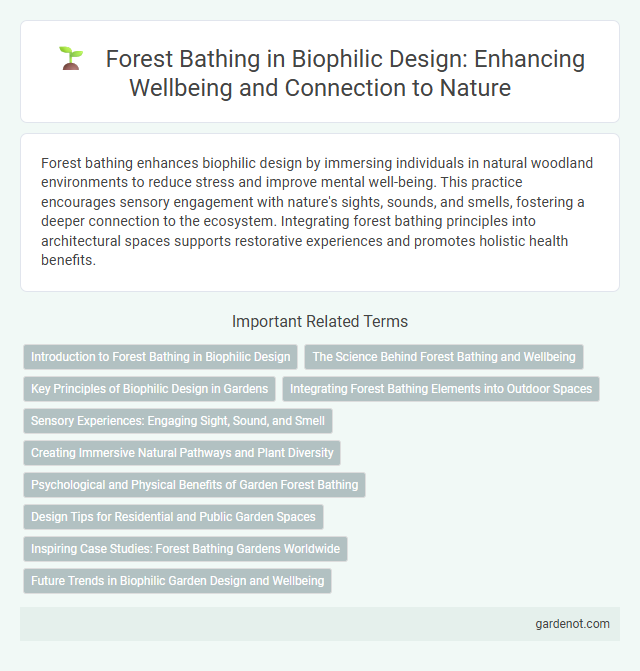Forest bathing enhances biophilic design by immersing individuals in natural woodland environments to reduce stress and improve mental well-being. This practice encourages sensory engagement with nature's sights, sounds, and smells, fostering a deeper connection to the ecosystem. Integrating forest bathing principles into architectural spaces supports restorative experiences and promotes holistic health benefits.
Introduction to Forest Bathing in Biophilic Design
Forest bathing, also known as shinrin-yoku, is a therapeutic practice integrated into biophilic design that emphasizes immersive experiences in natural forest environments to enhance mental and physical well-being. This practice encourages multi-sensory engagement with nature, fostering reduced stress levels, improved mood, and increased cognitive function through direct interaction with forest ecosystems. Incorporating forest bathing principles into architectural and interior design creates spaces that promote health by replicating natural elements, such as plant life, natural light, and organic materials.
The Science Behind Forest Bathing and Wellbeing
Forest bathing, or Shinrin-yoku, leverages phytoncides--natural compounds released by trees--that enhance immune function by increasing natural killer (NK) cell activity. Studies demonstrate reduced cortisol levels and lowered blood pressure after forest immersion, indicating decreased stress and improved cardiovascular health. Neuroimaging research reveals enhanced parasympathetic nervous system activation, promoting relaxation and mental wellbeing during and after forest exposure.
Key Principles of Biophilic Design in Gardens
Forest bathing incorporates the key principles of biophilic design in gardens by emphasizing immersion in natural environments, sensory engagement, and harmonious spatial layouts that mimic forest ecosystems. Gardens designed for forest bathing feature diverse plant species, natural materials, and water elements to enhance connection with nature and promote mental restoration. Integrating fractal patterns, organic shapes, and multisensory stimuli supports stress reduction and overall well-being through deeper interaction with the natural world.
Integrating Forest Bathing Elements into Outdoor Spaces
Integrating forest bathing elements into outdoor spaces enhances mental well-being by immersing individuals in natural environments that stimulate the senses through tactile textures, natural scents, and rhythmic sounds of wildlife. Design features such as dense tree clusters, moss-covered ground, and winding paths encourage slow, mindful walking and deepen the connection to nature, promoting stress reduction and improved immune function. Incorporating native plants and water features further supports biodiversity and creates a multisensory experience essential to effective forest bathing practices.
Sensory Experiences: Engaging Sight, Sound, and Smell
Forest bathing enhances sensory experiences by immersing individuals in the natural visual richness of greenery, encouraging deeper sight engagement with varying shades and textures of foliage. The gentle sounds of rustling leaves, bird calls, and flowing water foster auditory calm and connection to nature's rhythms. Aromatic elements like pine, cedar, and damp earth stimulate the olfactory system, promoting relaxation and emotional restoration through natural scents.
Creating Immersive Natural Pathways and Plant Diversity
Forest bathing enhances well-being by creating immersive natural pathways that engage all senses through a diversity of native plants, promoting relaxation and stress reduction. Incorporating varied plant species such as ferns, mosses, and flowering shrubs enriches the sensory experience and supports local biodiversity. Designing meandering trails with layered vegetation facilitates deeper connection with nature, encouraging mindfulness and restorative benefits.
Psychological and Physical Benefits of Garden Forest Bathing
Forest bathing in garden settings enhances mental well-being by reducing cortisol levels and alleviating stress-related symptoms. Exposure to natural elements like trees and foliage improves mood, cognitive function, and attention restoration. Physical benefits include lowered blood pressure, strengthened immune function through increased natural killer cell activity, and improved respiratory health.
Design Tips for Residential and Public Garden Spaces
Incorporate natural elements such as native plant species, water features, and varied topography to enhance the sensory experience in residential and public garden spaces. Design pathways that encourage slow, mindful walking and include secluded seating areas to facilitate immersive forest bathing. Utilize natural materials like wood and stone, and ensure ample shade and dappled sunlight to mimic forest environments and promote relaxation.
Inspiring Case Studies: Forest Bathing Gardens Worldwide
Forest bathing gardens like those in Japan, South Korea, and the United States offer immersive natural experiences that reduce stress and enhance well-being through sensory engagement with forest environments. The Shinrin-yoku trails in Japan exemplify successful integration of therapeutic nature walks supported by scientific research on mental health benefits. U.S. forest therapy gardens incorporate native plants and mindfulness sessions, demonstrating scalable models for urban biophilic design that foster relaxation and connection with nature.
Future Trends in Biophilic Garden Design and Wellbeing
Emerging trends in biophilic garden design emphasize immersive forest bathing experiences that enhance mental and physical wellbeing by integrating native plant species and organic forest elements. Innovative sensory pathways and curated natural soundscapes promote relaxation and stress reduction, aligning with the growing demand for restorative outdoor environments. Advances in technology enable personalized nature interactions, fostering deeper connections to natural ecosystems and supporting long-term health benefits.
Forest bathing Infographic

 gardenot.com
gardenot.com